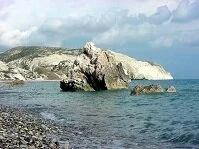Geography, Weather, & Wildlife of Cyprus
Geography

Aphrodite's Rock
Cyprus is an island nation in the eastern part of the Mediterranean Sea. There is debate as to what continent Cyprus belongs. As an island in the Mediterranean it can claim to be part of either Europe or Asia. Many people consider the country to be geographically in Asia, although many also consider southern (and perhaps northern) Cyprus to be culturally European, hence the genesis of the debate. Cyprus has no land borders, but is relatively close to Lebanon (east), Syria (east), and its closest neighbor, Turkey (north).
Geographically, Cyprus is a rocky island with some smaller mountains in the south, primarily in the southwest of the country. Other than the mountains, some coasts drop off into the sea, while others have long sandy beaches, making the sea quite accessible.